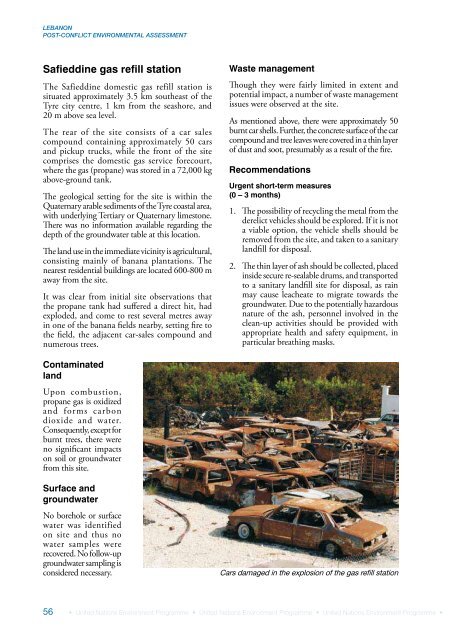Lebanon Post-Conflict Environmental Assessment - UNEP
Lebanon Post-Conflict Environmental Assessment - UNEP
Lebanon Post-Conflict Environmental Assessment - UNEP
You also want an ePaper? Increase the reach of your titles
YUMPU automatically turns print PDFs into web optimized ePapers that Google loves.
LEBANONPOST-CONFLICT ENVIRONMENTAL ASSESSMENTSafieddine gas refill stationThe Safieddine domestic gas refill station issituated approximately 3.5 km southeast of theTyre city centre, 1 km from the seashore, and20 m above sea level.The rear of the site consists of a car salescompound containing approximately 50 carsand pickup trucks, while the front of the sitecomprises the domestic gas service forecourt,where the gas (propane) was stored in a 72,000 kgabove-ground tank.The geological setting for the site is within theQuaternary arable sediments of the Tyre coastal area,with underlying Tertiary or Quaternary limestone.There was no information available regarding thedepth of the groundwater table at this location.The land use in the immediate vicinity is agricultural,consisting mainly of banana plantations. Thenearest residential buildings are located 600-800 maway from the site.It was clear from initial site observations thatthe propane tank had suffered a direct hit, hadexploded, and come to rest several metres awayin one of the banana fields nearby, setting fire tothe field, the adjacent car-sales compound andnumerous trees.Waste managementThough they were fairly limited in extent andpotential impact, a number of waste managementissues were observed at the site.As mentioned above, there were approximately 50burnt car shells. Further, the concrete surface of the carcompound and tree leaves were covered in a thin layerof dust and soot, presumably as a result of the fire.RecommendationsUrgent short-term measures(0 – 3 months)1. The possibility of recycling the metal from thederelict vehicles should be explored. If it is nota viable option, the vehicle shells should beremoved from the site, and taken to a sanitarylandfill for disposal.2. The thin layer of ash should be collected, placedinside secure re-sealable drums, and transportedto a sanitary landfill site for disposal, as rainmay cause leacheate to migrate towards thegroundwater. Due to the potentially hazardousnature of the ash, personnel involved in theclean-up activities should be provided withappropriate health and safety equipment, inparticular breathing masks.ContaminatedlandUpon combustion,propane gas is oxidizedand forms carbondioxide and water.Consequently, except forburnt trees, there wereno significant impactson soil or groundwaterfrom this site.Surface andgroundwaterNo borehole or surfacewater was identifiedon site and thus nowater samples wererecovered. No follow-upgroundwater sampling isconsidered necessary.Cars damaged in the explosion of the gas refill station56 • United Nations Environment Programme • United Nations Environment Programme • United Nations Environment Programme •
















